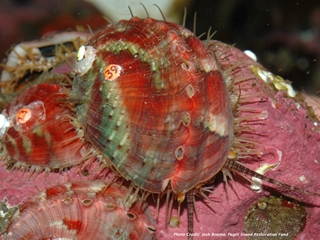
Project Year: 2014 - Present
Background: Pinto 'Northern' abalone (Haliotis kamtschatkana) is the only known indigenous abalone species in Washington State. Since 1992, pinto abalone populations have continued to significantly decline, despite closing the recreational fishery in 1994. There has never been a commercial fishery for abalone in Washington State. Pinto abalone are considered functionally extinct in Washington State waters and have been federally listed as a "Species of Concern" since 2004. They were recently listed as a State endangered species in 2019.
Abalone are broadcast spawners, meaning they release sperm and eggs into the water column, so there must be other abalone in close proximity for successful fertilization. It is believed that the remaining pinto abalone densities in the Salish Sea are too far below the threshold to facilitate the reproduction necessary for the population to recover on its own. Recovery without human intervention appears unlikely.
Project Description: Restoration efforts for pinto abalone in Washington State are underway including outplanting of captive-bred juveniles. Puget Sound Restoration Fund (PSRF) leads a strong collaborative team of organizations, government agencies, universities and tribes pursuing recovery strategies for pinto abalone. Since 2003, the restoration group has been investigating tools including conservation aquaculture and captive breeding, juvenile and larval outplanting, agreggation and other strategies.
Skagit MRC has been partnering with PSRF since 2014 to continue to build upon ongoing research and restoration efforts for pinto abalone.
Since 2009, nearly 45,000 healty, genetically diverse hatchery produced juvenile pinto abalone have been outplanted to 28 different restoration sites in Skagit, San Juan, and Island cocunties. 18,000 of these hatchery produced abalone have been outplanted to eight rocky reef sites in Skagit County waters.
Diver surveys are conducted each year to measure growth, signs of natural recruitment, density, and survivorship of the pinto abalone outplants. Preliminary monitoring results indicate the abalone are growing larger in size and density with their numbers increasing and spreading beyond the four original plots near Fidalgo Island.
In addition to hatchery work, outplanting, and diver surveys, water quality loggers are used to help track temperature, PH, dissolved oxygen, and salinity. Time laps cameras have also been installed at some of the outplant sites to study abalone movement and predation.
View the PSRF Recovery Plan for Pinto Abalone in Washington State. Learn more at www.pintabalone.com.
Skagit MRC's pinto abalone restoration work has been federally funded in part by the US Environmental Protection Agency via the Puget Sound Partnership through a grant awarded to the Northwest Straits Marine Conservation Initiative and the Skagit MRC.
- 2022 Pinto Abalone Report
- 2021 Pinto Abalone Report
- 2020 Pinto Abalone Report
- 2019 Pinto Abalone Report
- 2018 Pinto Abalone Report
- 2017 Pinto Abalone Report
- 2016 Pinto Abalone Report
- 2015 Pinto Abalone Report
- 2015 Pinto Abalone Outplanting
- Pinto Abalone Need You Poster
- Pinto Abalone Brochure
- Pinto Abalone Flier 2011
- Abalone Tagging